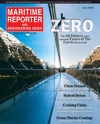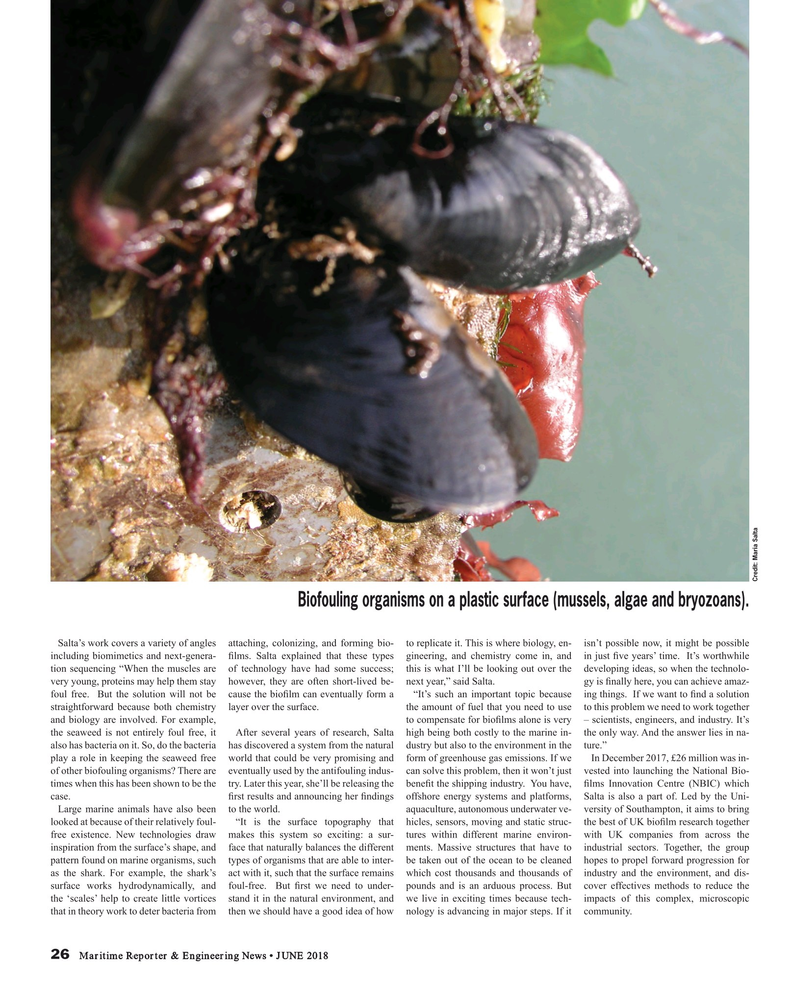
Page 26: of Maritime Reporter Magazine (June 2018)
Green Marine Technology
Read this page in Pdf, Flash or Html5 edition of June 2018 Maritime Reporter Magazine
Credit: Maria Salta
Biofouling organisms on a plastic surface (mussels, algae and bryozoans).
Salta’s work covers a variety of angles attaching, colonizing, and forming bio- to replicate it. This is where biology, en- isn’t possible now, it might be possible including biomimetics and next-genera- ? lms. Salta explained that these types gineering, and chemistry come in, and in just ? ve years’ time. It’s worthwhile tion sequencing “When the muscles are of technology have had some success; this is what I’ll be looking out over the developing ideas, so when the technolo- very young, proteins may help them stay however, they are often short-lived be- next year,” said Salta. gy is ? nally here, you can achieve amaz- foul free. But the solution will not be cause the bio? lm can eventually form a “It’s such an important topic because ing things. If we want to ? nd a solution straightforward because both chemistry layer over the surface. the amount of fuel that you need to use to this problem we need to work together and biology are involved. For example, to compensate for bio? lms alone is very – scientists, engineers, and industry. It’s the seaweed is not entirely foul free, it After several years of research, Salta high being both costly to the marine in- the only way. And the answer lies in na- also has bacteria on it. So, do the bacteria has discovered a system from the natural dustry but also to the environment in the ture.” play a role in keeping the seaweed free world that could be very promising and form of greenhouse gas emissions. If we In December 2017, £26 million was in- of other biofouling organisms? There are eventually used by the antifouling indus- can solve this problem, then it won’t just vested into launching the National Bio- times when this has been shown to be the try. Later this year, she’ll be releasing the bene? t the shipping industry. You have, ? lms Innovation Centre (NBIC) which case. ? rst results and announcing her ? ndings offshore energy systems and platforms, Salta is also a part of. Led by the Uni-
Large marine animals have also been to the world. aquaculture, autonomous underwater ve- versity of Southampton, it aims to bring looked at because of their relatively foul- “It is the surface topography that hicles, sensors, moving and static struc- the best of UK bio? lm research together free existence. New technologies draw makes this system so exciting: a sur- tures within different marine environ- with UK companies from across the inspiration from the surface’s shape, and face that naturally balances the different ments. Massive structures that have to industrial sectors. Together, the group pattern found on marine organisms, such types of organisms that are able to inter- be taken out of the ocean to be cleaned hopes to propel forward progression for as the shark. For example, the shark’s act with it, such that the surface remains which cost thousands and thousands of industry and the environment, and dis- surface works hydrodynamically, and foul-free. But ? rst we need to under- pounds and is an arduous process. But cover effectives methods to reduce the the ‘scales’ help to create little vortices stand it in the natural environment, and we live in exciting times because tech- impacts of this complex, microscopic that in theory work to deter bacteria from then we should have a good idea of how nology is advancing in major steps. If it community. 26 Maritime Reporter & Engineering News • JUNE 2018
MR #6 (26-33).indd 26 MR #6 (26-33).indd 26 6/6/2018 9:51:22 AM6/6/2018 9:51:22 AM

 25
25

 27
27
